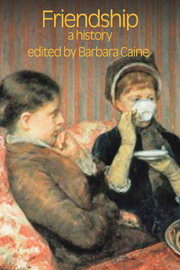Book contents
- Frontmatter
- Contents
- Preface
- Introduction
- 1 The Classical Ideals of Friendship
- 2 Cicero on Friendship
- 3 The Latin West
- 4 Renaissance Friendships: Traditional Truths, New and Dissenting Voices
- 5 From Christian Friendship to Secular Sentimentality: Enlightenment Re-evaluations
- 6 Taking up the Pen: Women and the Writing of Friendship
- 7 Class, Sex and Friendship: The Long Nineteenth Century
- 8 New Worlds of Friendship: The Early Twentieth Century
- 9 The Importance of Friends: The Most Recent Past
- Bibliography
- Index
4 - Renaissance Friendships: Traditional Truths, New and Dissenting Voices
- Frontmatter
- Contents
- Preface
- Introduction
- 1 The Classical Ideals of Friendship
- 2 Cicero on Friendship
- 3 The Latin West
- 4 Renaissance Friendships: Traditional Truths, New and Dissenting Voices
- 5 From Christian Friendship to Secular Sentimentality: Enlightenment Re-evaluations
- 6 Taking up the Pen: Women and the Writing of Friendship
- 7 Class, Sex and Friendship: The Long Nineteenth Century
- 8 New Worlds of Friendship: The Early Twentieth Century
- 9 The Importance of Friends: The Most Recent Past
- Bibliography
- Index
Summary
Two Images of Renaissance Friendship
Two images, one documentary and English, the other visual and Italian, give us at once some idea of the rich variety and vitality of the lived friendships experienced in European societies between the late thirteenth and early seventeenth centuries; and of the ubiquity of late medieval and Renaissance discourses on friendship that informed, and were in turn shaped by, those everyday experiences and exchanges. Both examples afford us, too, the knowledge that Renaissance people, like their medieval counterparts, continued to be absorbed by classical concepts of friendship while nuancing and adapting (sometimes abandoning) them according to changing circumstances, audiences, experiences and ideas.
Our first example takes us to England. Early in 1460, William Worcester, a connection of the Paston family, wrote thanking an unnamed friend for his kindly letter. “A very frende at nede,” he began – quoting, whether consciously or not, the title of a popular English poem in praise of friendship written by John Lydgate – “experience will schewe be deede, as wele as be autoritè of Aristotle in the Etiques that he made of maralité; also by the famous Reamayn Tullius [Cicero] in his litell booke de Amicicia; thangyng you for olde contynued frendschip stidffastely grounded …” Worcester had read Cicero's On Friendship in the original language, as numerous people had done before him and countless others were to do after.
- Type
- Chapter
- Information
- FriendshipA History, pp. 111 - 164Publisher: Acumen PublishingPrint publication year: 2009



